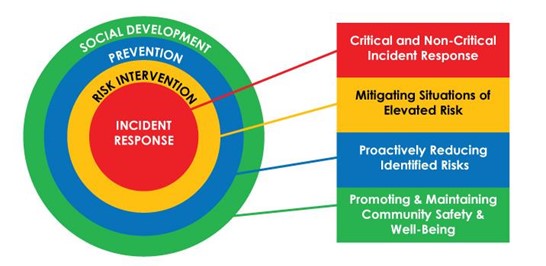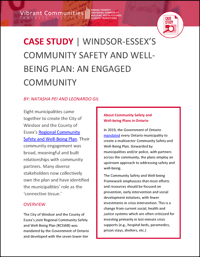In 2019, every municipality in Ontario was mandated to develop a Community Safety and Well-Being Plan that would move their activities and investments upstream.
Local governments, police departments and other community stakeholders would identify local levers for systems change and collectively shift from focusing mainly on incident response towards prioritizing early intervention, prevention and social development.

The diagram above represents the four layers of the Community Safety and Well-being Planning Framework proposed by the Government of Ontario, explained here.
A shared plan for the City of Windsor and County of Essex
With similar quality of life collaborations already underway within the municipalities and throughout the community, it was essential to the City of Windsor and nearby County of Essex not to duplicate work but to better align existing initiatives to increase resident well-being.
A community-engaged approach
The City of Windsor and County of Essex (Windsor-Essex) used a community-engaged approach to develop their shared Regional Community Safety and Wellbeing Plan (RCSWB). They felt this approach was necessary so that the strategy would represent all eight municipalities’ different contexts (strengths, needs, priorities), identify and address root causes of safety and well-being and be guided by lived expertise.
The RCSWB Team built relationships with community members and groups from various backgrounds, taking extra time and effort to avoid the “check box” style of engagement.
They built understanding amongst municipalities and community members as to why the collaborative response was so important.
Some 1,900 stakeholders were consulted over 91 virtual engagements.
Changes over time
As a result of their community-engaged approach, systems have already begun changing, including the following:
- New partnerships and power dynamics – The development of an Enhanced Sector Network brought together historically underrepresented community groups to contextualize data and avoid duplicating work. It ensured they could directly shape the plan’s key elements, such as metrics and activities.
- New partnerships and resource flows - The project team has five collaborative grant applications, including $1.5M for public substance use and opioid education and training strategy; all partnerships are new.
- New practices – Participants felt heard and understood during the process and saw their recommendations in the final plan. Windsor-Essex has committed to continual community engagement and sharing best practices across municipalities.
Using the community-engaged approach also improved buy-in from community groups and is anticipated to expedite implementation.
Read the case study
The new case study, Windsor-Essex’s Community Safety and Well-Being Plan: An Engaged Community, explores the community-engaged approach that Windsor-Essex’s RCSWB Team used challenges they had to navigate, and considerations for municipal staff running community engagements.
Further reading
- See the case study: Windsor-Essex’s Community Safety and Well-Being Plan: An Engaged Community
- Read our case study on the City of Vancouver’s Reduced Fare Transit Pilot
- Learn more about community engagement in rural Ontario





